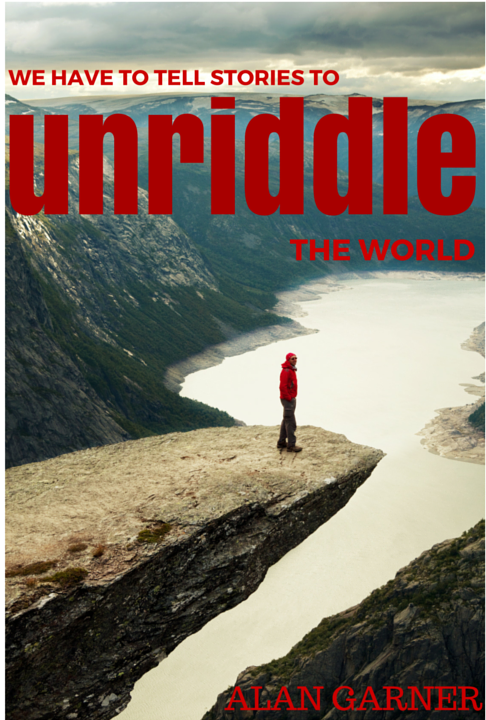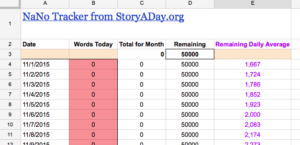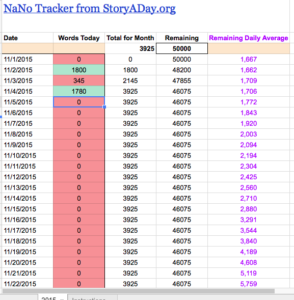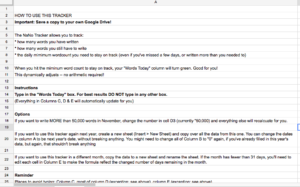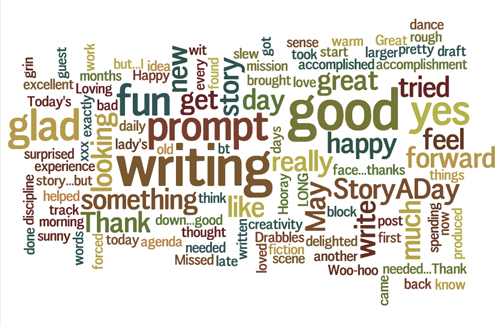Writing a story a day is hard. No doubt about it.
In fact, I had long been scared to commit to writing a novel, but after completing my first StoryADay back in 2010, I said, “Surely writing the same story every day for a month has to be easier than that!” and plunged into NaNoWriMo later that year and ‘won’. (I recently completed that novel – my first!)
So Why Keep Writing A StoryADay Each May?
Writing 31 short stories in a month drives you to the brink of desperation…and it’s right at that brink where interesting things start happening.
- You stop caring about whether the story is good and just get it written.
- You try crazy ideas that sometimes turn into highly original stories.
- You find yourself seeking out story ideas all day, every day, because you know you’ll need a new one tomorrow.
- You discover that the more you write — the more ideas you use up — the more creative you become. You never run out of ideas. There’s always another one coming along right behind it.
- You discover you can write more than you thought you could. Even if you’re exhausted every day, it’s only one month. You’ll be amazed what you can do with a deadline, a community and little bit of stubborn. And it will feel exhilarating.
Keeping Things Fresh
Past participant Sarah Cain had just finished a novel and was deep in the business of revising the manuscript and looking for an agent, when she found herself in a creative slump. She heard about StoryADay and was intrigued.
“[I thought] would be a change,” she says. “Give me a chance to get some creative energy flowing, which it did. I had great fun with it, and now write quite a lot of flash fiction.”
In addition, she went back to her novel revisions, refreshed and reinvigorated. The following year she landed an agent and signed a two-book deal for that novel and its sequel.
So How Do You Write A StoryADay Without Burning Out?
There are lots of ways to keep writing. Here are some that other StoryADay writers have used:
Accept that these are first drafts — Don’t revise as you write. Just keep moving the story forward, every day until you get to the end. No revisions, no backtracking. Finish with a flourish, drop your pen and walk away. You have the rest of the year to revise these things!
Finish each story — Do your heroic best to get to the end of each story. Even if you have to write something like “[get Frank from the school to the roof of the hospital. Car chase! Explosions]” and skip to the resolution, get to the end of the story.
Resolve as many loose ends as you can and put it on the ‘to be revised’ pile for June. There is an energy about finishing a story that buoys you up for the next one. “You can do this,” it whispers in your ear as you sit down to write the next day. “You told a complete tale yesterday. No reason you can’t do it again today.”
Allow yourself to experiment—Write short-short stories, longer stories, stories that are all dialogue, stories that rhyme, retelling of old stories, retellings of your own stories (in a different point of view, or setting…the possibilities are endless).
Some days you’ll need to do what feels like ‘cheating’ by rewriting a fairytale or reimagining a story of your own, just so you don’t have to work out all the detail. That’s OK. It worked out fine for Gregory Macguire and for Walt Disney…
Allow yourself to fail — You will have some days when it is torture and you when you get to the end of a story and think “what was that?!”. Learn to laugh it off. If you can, figure out why it didn’t work. (Did you forget to give the character something to root for? Did you not know enough about the exotic setting you tried to use? Did you start writing when you were too tired?)
Write down the lessons learned and save them for future reference.
Have A Backup Plan To Help You Start Again—There may be days when time gets away from you and you don’t finish a story. Or whooosh! The whole day goes by and you just forget to write. Prepare for this by having an “if/then” plan in place (an idea I came across in Gretchen Rubin’s excellent new book Better Than Before). Tell yourself “If I miss a day, then I’ll pick right back up the next day. I won’t try to catch up, I’ll just move forward”. Or maybe you can say “If I miss a day, then I’ll confess my sins in the StADa community, and get back to it the next day.” Or some other (positive) “If/then” cycle. All is not lost when you mess up if you have planned for what you’ll do after the inevitable slip.
Join the community — Yes, yes, I know. There’s a danger here. You could spend so much time reading other people’s posts that you never get around to posting, yourself. BUT, there is nothing like a little pat on the back, or a little peer pressure, to make us better than we think we can be. At least post in the Victory Dance group every day after you write something. Congratulate a few other people who have posted, and post a micro-update about your own day. Use the other boards to ask for help, or find a shoulder to cry on when the day didn’t work out as you had hoped.
Don’t ‘quit’ — If you get to day 14 and your life implodes, don’t quit. Change the rules. Admit that life got in the way and you can’t write a story a day this month, BUT commit to writing at least two more stories this month, or one, or whatever you feel you can manage. Come back to the challenge at least one more time.
You’re not failing. You’re learning. Write down what you’ve learned about your writing habits, needs, preferences, struggles, successes, so far this month. Post them somewhere you can find again (a blog is a great place, since it’s archived). Then commit to writing at least one more story before the challenge ends.
Make a note in your diary to check in to the community before the end of May and celebrate the progress everyone has made. Print out your winner’s tiara and wear it with pride, because you showed up. You wrote. You win.
Tomorrow we’re going to talk about story sparks, writing prompts and what you can do NOW to make sure you have the best chance possible of writing 31 stories during StoryADay May. I’ll also be reminding you that I’ll be releasing I have published the StoryADay Guide: A Month of Writing Prompts 2015 on Monday, April 20. Until May 1, 2015 it’ll be selling at a steep discount, so don’t miss that!
Hint: it’s going to look a lot like last year’s edition, but with all-new prompts, tips and pep-talks.
If you want to make sure you receive the rest of this series and notifications about the discounted ebook, and the opening of the StoryADay Community for 2015, join the Advance Notice List:


